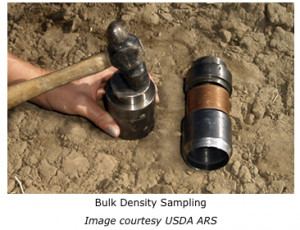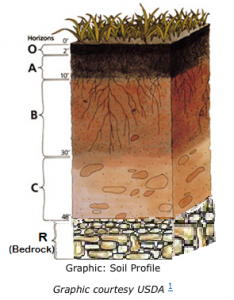Soil Health is defined as the suite of biological, chemical, and physical properties which enable soils to function as a vital living ecosystem that sustains all life above and underneath the soil surface.
During the past century, the focus of maximizing agricultural production and profitability has centered on technological innovations – improving genetics for disease and insect resistance, herbicide-tolerance, drought and heat tolerance, and higher yields. Traditional yet important agricultural methods, such as building and caring for soil, have gotten less attention. For some farmers, this trend has reduced their long-term sustainability by exacerbating problems such as herbicide resistance, erosion/nutrient runoff , and yield losses from drought and flooding. Soil health improvement can help meet surface and ground water quality goals, reduce soil erosion, and mitigate the impacts of climate change. Recently, private companies, government agencies, and non-profits have begun to recognize the value of soil health and the ecosystem services it can enhance. Implementing a soil health system in the production of food, fiber, and fuel can dramatically impact not only air and water quality, but improve farm economic sustainability and quality of life in rural areas.
Structure of Soil
SOIL PROFILE
The soil profile is the arrangement of soil layers leading down from the soil surface. These individual layers are called soil horizons and differ in a number of easily seen soil properties—such as color, texture, structure and thickness. Other properties such as chemical and mineral content, consistency and reaction require special testing.
Secondary Soil Structure
Secondary structure is how different soil particles interact. Characteristics include bulk density, aggregate formation and pore size or porosity. Secondary characteristics strongly interrelate with each other and with primary characteristics.
BULK DENSITY
What is bulk density and why does it matter to soil health?
 Bulk Density is an indicator of soil compaction and soil health. It affects infiltration, rooting depth/restrictions, available water capacity, soil porosity, plant nutrient availability and soil microorganism activity, which influence key soil processes and productivity. Bulk density is the weight or mass of a unit of soil divided by the volume of soil. Bulk density varies depending on soil type. For example, clay particles are much smaller than sand particles, and thus have a greater surface area than sand. Therefore, a dry clay soil will have a lower bulk density value because it has more pore spaces in a volume than does a sandy soil.
Bulk Density is an indicator of soil compaction and soil health. It affects infiltration, rooting depth/restrictions, available water capacity, soil porosity, plant nutrient availability and soil microorganism activity, which influence key soil processes and productivity. Bulk density is the weight or mass of a unit of soil divided by the volume of soil. Bulk density varies depending on soil type. For example, clay particles are much smaller than sand particles, and thus have a greater surface area than sand. Therefore, a dry clay soil will have a lower bulk density value because it has more pore spaces in a volume than does a sandy soil.
AGGREGATES
Aggregates are the clumps formed when soil particles stick together. This clumping characteristic is important for keeping soil on the land and preventing runoff. Organic matter in the soil is the glue that holds aggregates together.
Large stable aggregates have a range of pore sizes, from small pores within the aggregate to large pores between the aggregates, which allows for high infiltration rates. Soils with good aggregate quality can capture all the water in a typical rain event. Aggregates are one type of soil structure. Soils also can be sorted into different basic structures: single-grain, blocky, platy, massive, prismatic and granular. When aggregates break down into large cohesive masses with no pore spaces, the soil structure is called massive.
Some deposits, such as sands in a sand dune, are called single-grain because there is little to no attraction between sand grains and are basically structureless. On the other textural extreme, some clay soils occur as large cohesive masses and are termed massive in structure. However, many soils exhibit definite and repeatable shapes that can be grouped into four general categories.
- Granular structure is generally spherical in shape, with outer surfaces that do not fit well together. Granular structure is most commonly found in surface horizons, especially those enriched with organic matter (an A horizon). Grassland vegetation and earthworm activity encourage granular structure.
- Block-like structure is similar in shape to a cube: all dimensions are of nearly equal length.
- Prism-like structures are those that are longer than they are wide. They vary in height from horizon to horizon and from soil to soil and are often associated with swelling types of clays.
- The final structure shape is called platy, because it is characterized by relatively thin horizontal structures similar to stacked plates. Unlike other shapes, it may be inherited from a soil’s parent material, especially if it was deposited by water (alluvium, flowing water or lacustrine, lake water) or ice (glacial).
Aggregate Stability and Pore Size
Aggregate stability and pore size are critical for infiltration, root growth and resistance to water and wind erosion. Aggregate stability and pore size and can be evaluated using the slake test.
PORE SIZE, POROSITY AND INFILTRATION
Pore size and porosity are essential for air, water and nutrient movement into soil and for creation of spaces for soil biota such as fungi, nematodes/worms, insects and arachnid that live in the soil. Pore space also provides zones of weakness for root growth and root penetration deep into the soil column. Pores also help facilitate seed germination.
As you’ve learned in this unit, infiltration is critically important to the health of a crop and the health of the environment. An increase of just one half inch of soil’s water-holding capacity means a corn field can go up to two extra days without rain during the critical pollination period. Over the entire Mississippi River basin, the increased infiltration is the same amount of water that flows over Niagara Falls in almost 12 weeks!
Land Management Systems and Water
Because of the intricate linkages between soil properties and water, land management systems directly affect water quality and water availability for crop production. Conventionally managed soils are ‘leaky,’ with diminished infiltration and water holding capacity. Soil conservation practices focused on improving soil health can slow water movement and retain moisture for crops. For example, the USDA NRCS factsheet “Healthy, Productive Soils Checklist for Growers,” describes seven soil health management systems and their benefits to soil health. All of these soil conservation practices have benefits for water quality or soil-water dynamics.
- Conservation Crop Rotation: holds soil moisture, improves water quality, conserves water
- Cover Crop: conserves soil moisture, improves water quality, conserves water, improves water efficiency to crops
- No-Till: improves water holding capacity of soils, improves water efficiency, conserves water, and improves water quality
- Mulch Tillage: increases soil moisture for plants, improves water quality, conserves water
- Mulching: conserves soil moisture, improves water quality, conserves water
- Nutrient Management: keeps nutrients in the soil, improving water quality
- Pest Management: reduces pesticide losses to the environment
Capturing the benefits of a healthy soil-water dynamic starts with assessing current soil health and farm practices. Then, specific practices that will improve soil water quantity and quality can be identified and implemented. Often, multiple practices to improve soil-water dynamics can act synergistically, creating better results than a single practice alone. For examples of how soil conservation practices can provide multiple soil health benefits, read the NRCS factsheet “Healthy Productive Soils Checklist for Growers.”
Additionally, SARE publishes a “Building Soils for Better Crops” book providing a practical guide to ecological soil management with background information as well
as step-by-step information on soil-improving practices which is a great resource for farmers, farm advisors and students of soil health.
The foundation of the soil health initiative is to work with the natural soil ecosystem to achieve production and economic goals, while also recognizing the societal and environmental benefits of changing production techniques and strategies. Many believe a production system grounded in the promotion of soil health is the basis of sustainable and resilient food, feed, fiber, and fuel production. Simply put, as the agriculture industry ramps up its research, development, and production efforts to feed the estimated nine billion people who will inhabit the earth by year 2050, we cannot forget that soil—the living, breathing organism under our feet—is the foundation for food production today and for the future.

